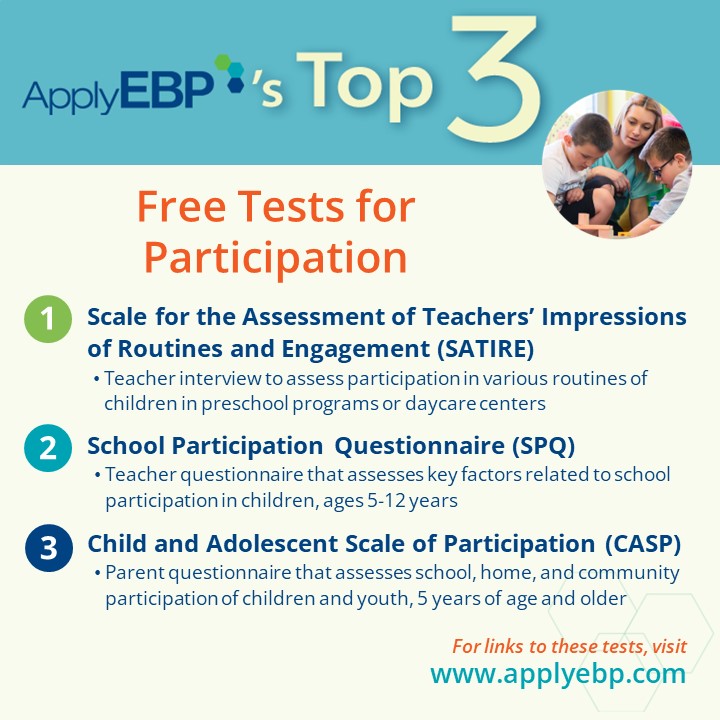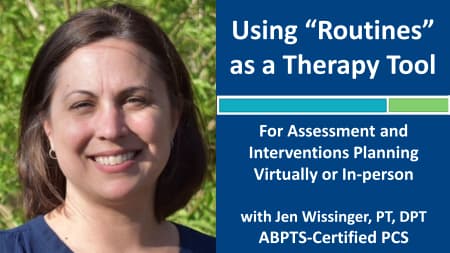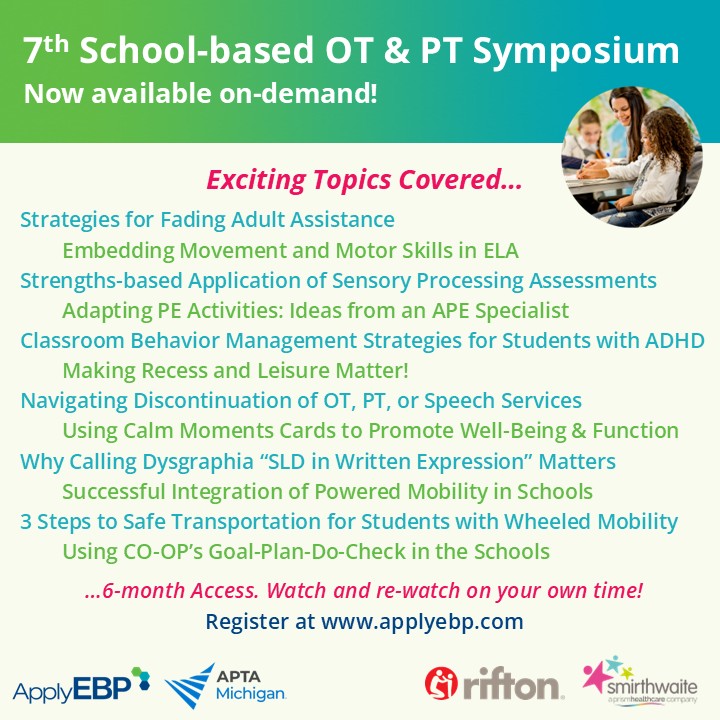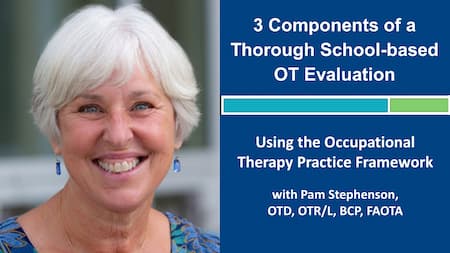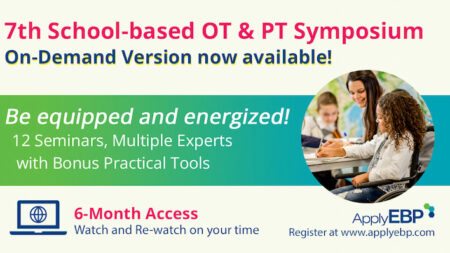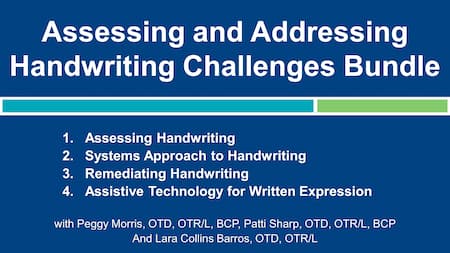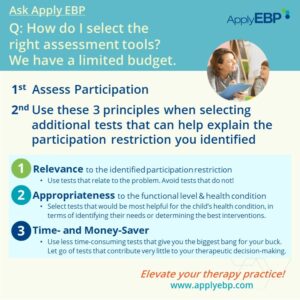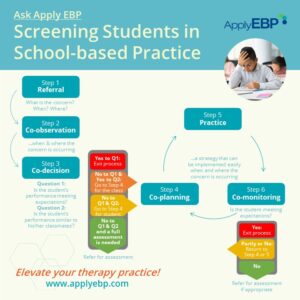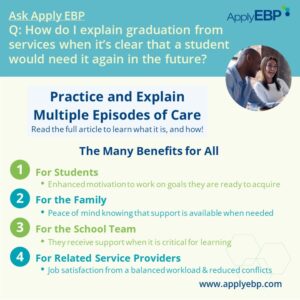Ask Apply EBP
Top 3 Free Tests for Participation
Note that this article is part of a series of articles on assessment. If you have not done so, first, read this articles:
-
-
-
- Must-Have Test and Organizing Your School-based Assessment – discusses the 5 critical reasons for assessing participation first
- 3 Principles for Selecting Tests – discusses the 3 principles to use when selecting tests at the activity and body function & structure levels
-
-
Q: What are the best tests…for measuring participation?
In our article “Must-Have Test and Organizing Your School-based Assessment”, we emphasize the importance of initiating assessments by evaluating your pediatric client’s level of participation. Below, we’ve compiled our top three favorite participation tests, all of which are freely available. The fact that they are free adds significant value, especially for practitioners with limited budgets. With these 3 in your toolkit, you have available to you participation tools that cater to individuals across all age groups, from 3 to at least 21 years old.
If you have resources allocated for assessment tools, you may also want to check our Top 3 For-a-Fee tests for Participation (coming soon!).
You can also learn how to get another free participation assessment tool in our article: Top 3 Uses of an Ecological Assessment, plus a free ecological assessment form
1. Scale for the Assessment of Teachers’ Impressions of Routines and Engagement (SATIRE)
The SATIRE consists of multiple pages with questions for different class/school routines “to develop functional intervention plans for children with special needs” (Clingenpeel & McWilliam, 2003).
-
-
- To download: Click here
- Best for: children in preschool programs or daycare centers
- Administration:
- Interview the teacher to gather information about different classroom routines (e.g., Arrival, Free Play, etc.).
- Use the questions on the left side of the form as examples of what you should ask.
- Use the right side of the form to write down the teacher’s answers.
- After discussing each routine, ask the teacher to rate their impression of the “goodness of fit” between the routine and the child’s functioning on a scale of 1 to 5, where 1 = Poor goodness of fit and 5 = Excellent goodness of fit.
- Why we like this test:
- It is perfect of preschoolers – an age where there are not a lot of participation tests
- The concept of “goodness of fit” acknowledges that disability is a mismatch between the child and the environment (i.e., the social model of disability). This also means that when planning interventions, we can target either the child and/or the environment to improve the “goodness of fit.” This is especially important for children with lifelong disabilities whose impairments may be less malleable to changes compared to the environment.
- While the test includes 12 routines, you can narrow down which routines to test by first asking the teacher about areas of most concern. There are 2 “blank” routines on page 8 for any routines not covered in the 12.
- What to note:
- The SATIRE is not a standardized test.
- The SATIRE can be used as part of a Routine-based Interview (RBI).
- Real-life utility:
- While it is not standardized, you can still use the “goodness of fit” rating to:
- Determine areas of strength (i.e., those with the highest ratings)
- Identify and prioritize routines that need to be addressed (i.e., those with the lowest ratings), and
- Measure progress after interventions (i.e., change in goodness of fit).
- You can also delve deep into the routines that rated higher, to find strategies that worked, which you can adopt in routines with lower “goodness of fit” ratings. For example, can a particular motivation that works well in Arrival also work in Circle time?
- While it is not standardized, you can still use the “goodness of fit” rating to:
- Limitation:
- Since it is not a standardized test, a general suggestion is to practice caution when interpreting results. Probe deeper into the teacher’s reply to the “goodness of fit” question. For example, you can ask a follow-up question, such as, “why did you score it a 2?”, or “what does it look like when the child scores a 5?”
-
2. School Participation Questionnaire (SPQ)
The SPQ is a teacher questionnaire “designed to assess key factors related to participation for children aged 5-12 years.” (CHILD: SPQ v1.4, 2020)
-
-
- To download: Click here
- Best for: school participation of 5-12 years old
- Administration:
- Have the teacher complete the form by rating their level of agreement with each statement (1 = Disagree, 2 = Somewhat Disagree, 3 = Somewhat Agree, 4 = Agree).
- Why we like this test:
- It is quick to complete – only 10 minutes
- It helps to identify, not just the level of participation, but more importantly the factors that influence the child’s ability to participate.
- The test looks at 4 factors that influence school participation:
- Being: child’s thoughts and feelings about themselves
- Doing: child’s actual actions
- Symptoms: related to child’s disabilities
- Environment: both the physical and social
- Test creators emphasize that practitioners determine the fit between the child and the environment (similar to the SATIRE above), and to support the child without viewing the child as the problem.” (CHILD: SPQ v1.4, 2020)
- What to note:
- It is a standardized test. There are multiple published and ongoing research that reports on its reliability, validity, and utility.
- Real-life utility:
- Consider higher ratings as strengths.
- Identify and prioritize lower ratings as areas of needs. Focus your interventions on these areas.
- Immediately address low scores in the Environment section to make the environment more inclusive. As mentioned above, the environment is often easily malleable to changes.
- Limitation:
- It is a newer test. However, the authors seem intent in continuing to research the psychometric properties and the utility of this tool.
-
3. Child and Adolescent Scale of Participation (CASP)
The CASP is a parent/guardian or youth self-assessment tool for measuring participation in the school, at home, and in the community.
-
-
- To download: Click here
- Best for: school, home and community participation for individuals 5 years and older
- Administration:
- There are 2 versions of this test.
- Parent/Caregiver version: parent/caregiver scores the child or youth’s level of participation at home, in school and in the community (1 = unable, 2 = very limited, 3 = somewhat limited, 4 = age expected).
- Youth version: youth scores their self-perceived participation level on the same 20 items
- They also answer open-ended questions 21-23, that delve into what they perceive as barriers and supports to participation, assistive devices or equipments, and any changes that have been implemented already to improve participation.
- There are 2 versions of this test.
- Why we like this test:
- It is short – can be completed in 10 minutes
- Can be used by home-based and clinic-based practitioners
- Can be used for older children/youth
- Has a self-report to seek a youth’s self-perception of their performance. Completing both the parent/guardian and youth versions can yield even richer answers.
- What to note:
- The CASP is a standardized test.
- The CASP was initially designed as part of the the Child and Family Follow-up Survey (CFFS). The CASP can be administered separately from the other components of the CFFS.
- Practical utility:
- Consider higher ratings as strengths.
- Identify and prioritize lower ratings as areas of needs. Focus your interventions on these areas. You can match your focus with your setting. For example, school-based practitioners can focus on school participation ratings; however, note that, if determined by the IEP team as important goals, school practitioners may also address independent living and community participation skills.
- The test creator, Gary Bedell, OTR, FAOTA, also provides these score interpretations guidelines to determine what is extremely limited to full participation. Use these guidelines with caution as they have not been peer-reviewed.
- Limitation:
- When using the Parent/Caregiver Version, respondent may have a hard time answering the “School” section with accuracy. But it’s a good way to start this conversation about their child’s school participation.
-
Not included in the list above is another free tool for testing participation – Ecological Assessment. You can click here for Apply EBP’s Top 3 Uses of an Ecological Assessment, plus a free ecological assessment form.
If you would like to learn more about the using the SATIRE, check out…
If you would like to learn more about interventions for participation, check out…
Find More Answers to Your Questions in Our...
Featured School
Symposium
7th Online School-based OT and PT Symposium - On-Demand Version
- Watch and re-watch on your own time
- On-Demand Version
- OTs, OTAs, PTs and PTAs
- $399-449
Featured Live
Workshop
6th Online School-based OT and PT Symposium - On-demand Version
- Watch and re-watch on your own time
- On-Demand Version
- OTs, OTAs, PTs and PTAs
- $399-449
Featured On-Demand
Webinar
Routines as a Therapy Tool
Featured Webinar
Bundle
Assessing and Addressing Handwriting Challenges Bundle
Have a question?
Submit here…
*Clicking submit will send your question directly to our email inbox. Your name and email will let us know that your submission is real (not spam). We will not include these in our posts, unless you tell us to include your name. Please read our privacy policy here.
All infographics and videos on www.applyebp.com are intellectual properties of Apply EBP, LLC
You may use the infographics and videos for free for any non-commercial, educational purposes. Please cite the source as “Apply EBP, LLC” and a link to the source article. If you plan to use any infographic or video for commercial purposes (i.e., for profit), please email Carlo@applyebp.com to obtain a written permission. Permission can be granted on a case-by-case basis.

